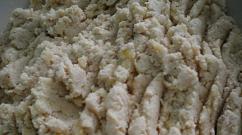Animals of the Arctic deserts narwhal. Narwhal
Narwhal (Monodon monoceros)- medium-sized representative of the suborder odontocetes (Odontoceti), known for having a long, straight tusk in males. The narwhal is one of two living whales from the narwhal family. (Monodontidae), along with the beluga whale.
Description
The average body length of a narwhal is about 470 cm for males and 400 cm for females. Average weight males - 1,600 kg, females - 900 kg. About one third of your weight is fat. The color of adults is brownish or dark gray on the upper part and light on the lower part, with a spotted pattern throughout the body. With age, the color becomes paler. The head is relatively small, the muzzle is blunt, and the nose is short and rounded. There is no dorsal fin, but on the back half of the back there is a small ridge about 5 cm long and 60-90 cm high.
On the upper jaw, narwhals have only two teeth. The teeth of females, as a rule, do not develop into a tusk. In males, the left tooth protrudes through upper lip, and develops into a straight tusk with a spiral pattern in a counterclockwise direction. The tusk reaches a length of one third to half the body length, and sometimes grows up to 300 cm and weighs 10 kg. In rare cases, a tusk develops from the right tooth. Sometimes one or even two tusks grow in females. The distal end of the tusk has a polished appearance, while the rest is usually covered with red or green algae. The internal cavity of the tusk is permeated with vessels and nerve endings.
Area

Narwhals live in the Arctic Ocean from the eastern Canadian Arctic to central Russia, but are occasionally found in the waters Eastern Siberia, Alaska and the Western Canadian Arctic.
Habitat
Narwhals occupy one of the northernmost habitats of any cetacean species, between 70 and 80° northern latitude. They are more demanding of their habitat than other whales and for this reason have a limited range. Narwhals are rarely found far from loose ice, and prefer deep waters. The largest concentrations of narwhals are concentrated in the Davis Strait, Baffin Sea and Greenland Sea. The advance and retreat of ice initiates migration.
In summer, narwhals occupy deep bays and fjords. The most famous and probably the world's largest population of narwhals lives in the deep bays of the eastern Canadian Arctic and northwestern Greenland.
Nutrition
Narwhals eat a variety of foods ranging from squid and fish to. The narwhal's multiple functional teeth are believed to be used to suck in and eject a jet of water to dislodge prey such as bottom-dwelling fish and shellfish. Their highly flexible necks help them explore wider areas and capture more mobile prey.
Behavior

The narwhal is a social animal and is usually found in schools of six to twenty individuals, although most groups tend to number between three and eight individuals. Smaller groups usually gather during the migration season to form a flock of hundreds or even thousands of individuals.
Narwhals remain in close proximity to the ice throughout the year. There are various hypotheses about the main functions of the tusk. Perhaps males use it for competition. It can also be used to obtain food. Since most females do not have a tusk, the most likely assumption is that these are secondary sexual characteristics.
Reproduction
The mating system of narwhals is still a mystery. The gestation period is about 15.3 months, with mating occurring in March - May and birth in July - August next year. The duration of lactation is unknown, but it is assumed that it is about 20 months. The interval between births is usually three years. Narwhals copulate in vertical position, belly to belly. Most often, a single baby is born, but there are also a few documented cases of twins being born. Birth occurs tail first. The body length of newborn narwhals is 1.5-1.7 meters, weight is about 80 kg, and the layer subcutaneous fat 25 mm. Physical maturity occurs at a body length of 4 meters and a weight of 900 kg in females and 4.7 meters and 1600 kg in males. These parameters usually correspond to ages from 4 to 7 years.
Lifespan

IN wildlife Narwhals can live up to 50 years or more, but captive breeding attempts have been unsuccessful. Given the fact that an adult male can grow up to 7 meters in length, narwhals are too large animals for most institutions to keep in captivity.
Role in the ecosystem
Economic value for humans: Positive
Historically, narwhals were the main source of food for many Arctic peoples.
Economic significance for humans: Negative
No known facts adverse economic impacts of narwhal on humans.
Security status

On the list International Union The Nature Conservancy (IUCN) has classified the narwhal as Near Threatened.
Video
If you find an error, please highlight a piece of text and click Ctrl+Enter.
Narwhal is:- Kingdom - Animals
- Type - Chordata
- Subphylum - Vertebrates
- Class - Mammals
- Order - Cetaceans
- Family - Unicorns
- Species - Narwhal
Narwhal (unicorn) is a mammal that belongs to the unicorn family and is the only species of the narwhal genus.
An adult narwhal has a body length of approximately 3.5 to 4.5 meters, while a newly born one is about 1.5 meters. Weight can reach 1.5 tons, and females weigh slightly less, about 900 kg, with approximately a third of the weight being fat. The dorsal fin is missing. The head has round shape, and the frontal tubercle that hangs over it. The narwhal's mouth is small and located at the bottom. By appearance and the size of the narwhal is very similar to the beluga whale, but adult individuals have grayish-brown spots on a light body that can merge, and the narwhal also has only 2 teeth on top. The narwhal's horn develops from the left tooth and reaches a length of up to 2-3 meters, weighs up to 10 kg, and is twisted in a left-hand spiral. The right tooth in males and both teeth in females, as a rule, do not erupt and are hidden in the gums. There are cases, approximately 1 in 500, exceptions to the rules. If the tusk is broken, it does not grow back, but the tooth canal, which turns out to be open in this case, is closed with a bone filling. The narwhal's tusk is very elastic and durable; its end can bend up to 31 cm in any direction without damage.
To date, the exact purpose of the tusk has not been clarified. But it is known that it is not an attack weapon and does not serve to break through ice. However, there is an opinion that the tusk is a sensitive organ, and it is penetrated by millions of small tubes with nerve endings, this has been revealed under electron microscope. It is also assumed that the narwhal uses its tusk to sense changes occurring in the water. And when narwhals cross their tusks, they apparently clean off growths from them.
The narwhal's habitat is the Arctic Ocean and the North Atlantic, that is, in the cold waters along the edge arctic ice. This is mainly the Canadian archipelago and the shores of Greenland, as well as the waters of Spitsbergen, Franz Josef Land, the northern tip of the North Island New Earth. Narwhals swim north, up to 85 north latitude, in warm weather, and in winter they can swim south to Great Britain and the Netherlands, the Murmansk coast, White Sea and the Bering Islands making seasonal migrations. IN summer time Narwhals stay at depth, unlike, for example, beluga whales. And in cold times they live among the ice, and if these gaps freeze, then the narwhals break through the ice by striking with their backs or tusks. The thickness of the ice that narwhals can break through is about 5 cm.
The narwhal's diet includes mainly cephalopods, with crustaceans and fish a little less common. As a rule, they like to feast on bottom representatives of the ichthyofauna - cod, stingrays, halibut, flounder, gobies. The narwhal can dive 1 km for food and remain at depth for a long time. It is also known that the narwhal lifts bottom-dwelling fish from the bottom with the help of its tusks.
In addition to humans, the narwhal has other enemies, these are polar bears, killer whales and polar sharks, the latter attack the cubs.Narwhals swim either alone or in small schools of 6-10 individuals. Such flocks consist of males or females with cubs. Previously, large groups of several hundred or even thousands of individuals were noticed. In groups, narwhals talk to each other with sharp sounds that resemble whistles, sighs, moos, clicks, gurgles and squeaks. Narwhals mate mainly in the spring. The gestation period lasts 14-15 months, after which 1, rarely 2 cubs are born. Sexual maturity occurs at 4-7 years, at which time males grow up to 4 meters in length, and females up to 3.4 meters. Narwhals live very short lives in captivity, up to 4 months, and do not reproduce, but in the wild they live up to 55 years.
Narwhals are caught mainly by northern peoples, in particular Eskimos. They eat meat, use the fat to fuel lamps as oil, and use the intestines to make ropes. Crafts are made from tusks. In 1976, the Canadian government introduced restrictive measures on narwhal fishing.
The narwhal population numbers approximately 40-50 thousand individuals. This species is listed in the Red Book of Russia and is considered rare.
I would immediately like to answer the question of our readers about what a narwhal is - an animal or a fish. This is a mammal belonging to the cetacean family. This is the only species of narwhal.
The animal narwhal, or aquatic unicorn, lives in the Arctic Ocean, is a beluga whale and belongs to the family of cetacean mammals.
Appearance
This is a very large animal - the narwhal. Its (male) weight reaches 1.5 tons. The length of an adult is 4.5 meters, and up to one and a half meters is the length of a baby. More than half of an adult narwhal's weight is fat. Females are somewhat more graceful, their weight is only 900 kilograms.
Externally, narwhals are very similar to beluga whales. But they are distinguished by a huge horn. More often it is called a tusk. This is a large and durable formation, 2-3 meters long and weighing 10 kg. The tusks are able to bend in different directions without breaking.
Why do I need a narwhal horn?
The functions of the tusk are still not fully understood. True, today scientists confidently declare that it is not intended to break through the ice crust or attack the victim.
At first, a version was voiced that the animal narwhal uses its horn in mating games - to attract a female. It was based on observations. The fact is that during the mating season, these giant animals really constantly touch their tusks.
In 2005, a scientific expedition observing the life of narwhals concluded that this formation is extremely sensitive. When studying it, a huge number of nerve endings were discovered on its surface.
Scientists have once again seen how unique the narwhal (animal) is. The tusk, which measures temperature and frequency of electromagnetic waves, is the next version of its purpose.
Hypersensitive tusk

The narwhal horn is revered and prized across cultures - it can be used as jewelry royal thrones and palaces. In England, the narwhal tusk became the royal scepter. Queen Elizabeth paid for one tusk of this northern giant in the 16th century a fantastic sum for those times - 10 thousand pounds. With this money it was possible to build a castle. What is so remarkable about the process?
Narwhals belong to a small suborder of the so-called toothed whales. Despite this, in fact they are toothless creatures. There are no teeth at all, and on the top there are only two rudiments. Cubs may have six pairs of upper and a pair of lower teeth, but they fall out very quickly, and in place of the left tooth, males begin to develop a tusk, which by the time the animal matures reaches 2-3 m in length, 7-10 cm in thickness or more 10 kg weight. Only males are adorned with long tusks. The female has a straight and shorter horn. Very rarely, but it happens that both teeth in females degenerate into tusks; and in males the left fang does not become a horn, but these are quite rare exceptions.
The narwhal tusk has a spiral striation (cut) on its surface, which significantly increases its strength. This cutting appears over a long period of time: during the forward movement of the animal, the tusk, overcoming the powerful resistance of the water, slowly rotates around its own axis. As a result, the walls of the hole cut spiral grooves on its forming surface.
Very rarely there are males with two tusks, which were formed from two teeth at once. According to statistics, such animals occur one in 500 adults.
Surprisingly, even today the narwhal animal, and in particular its horn, remain a mystery to scientists around the world. It has been little studied.
Today, researchers believe that the tusk allows the narwhal to sense changes in temperature, pressure, and concentration of suspended particles in the water.
Lifestyle

Narwhal is an animal (we posted the photo in this article) that winter time dives to a depth of 1.5 km. This is necessary to protect yourself from the icy Arctic waters. After some time, it rises to the surface for air and again goes deeper. He makes about 15 such dives per day. In addition, narwhals have subcutaneous fat as a reliable protection against the cold. Its layer sometimes exceeds 10 cm. In summer, these animals are usually found at a depth of 30 to 300 m.
Nutrition
The Arctic animal - the narwhal - feeds mainly on various species. The main enemies of these powerful animals are killer whales and polar bears. The cubs are sometimes attacked by sharks.
Family
The narwhal animal can live completely alone or in a small group, which includes up to 10 adult males or females with offspring.
Previously, these giants created large herds numbering several hundred, and sometimes thousands of animals. Today it is rare to see a group of more than a hundred animals. Sometimes they are joined by beluga whales.
Like other gregarious cetaceans, these animals communicate with each other using vocalizations. Most often these are sharp sounds similar to whistling, groaning, clicking, mooing, gurgling, and squeaking.
Reproduction

Mating occurs in the spring. Pregnancy lasts 14 months, the full reproductive cycle is 2-3 years. Usually one, much less often two, cubs are born. Puberty occurs at 7 years of age. There have been no recorded cases of these animals breeding in captivity.
The female feeds the cub very full fat milk 20 months.
Life in captivity
The aquatic unicorn is one of the few that cannot tolerate captivity at all. This is evidenced by the irrefutable fact that not a single animal has ever survived more than six months in captivity, while in captivity they live up to 55 years. The exact number of narwhals has not been established, but they are a small, rare species that is already listed in the Red Book of the Russian Federation.
With full confidence they can be called one of the wonders of the Arctic, the only one of its kind.
Habitat

We have already mentioned that these powerful animals live in the harsh northern regions. They are most common in the Arctic seas and the Arctic Ocean. Narwhals can be found off the coast of Greenland, as well as in the northern parts of the Canadian Arctic Archipelago.
Small groups have been recorded in the northeast of Franz Josef Land, very rarely between Kolyma and Cape Barrow. This is due to the lack of feed - there is little cephalopods. Stations « North Pole» groups of narwhals have been recorded to the north. They live in cold waters along the edges of the Arctic ice, making seasonal migrations: in the summer - to the north, and in the winter - to the south.
The meat of aquatic unicorns is eaten. They also use the fat of these animals as a means for a lamp (wick). Guts are used to make ropes and twines. But the mysterious horn, or tusk, is especially valuable. Northern craftsmen make various crafts from it.

Population
The narwhal animal is a small species that is on the verge of extinction. In the Middle Ages, because of his horn, which, according to shamans, has magical power, these mammals were destroyed in huge numbers.
Even today, an unusual tusk can cause an animal to be killed. They are hunted by Eskimos. If in the old days hand harpoons were used for hunting, today motor boats and automatic devices are used to kill narwhals.
Anyone who sets their sights on this rare animal needs to know that these are living indicators of the ecosystem, they sense the slightest climate changes and are sensitive to environmental pollution.
Occupant arctic seas with the scientific name Monodon Linnaeus - Unicorn. This is the rarest whale in the world - mysterious creature ocean.
The narwhal has a large horn, a tusk, which makes the whale unique and special. In the male, the tooth turns into a spiral-twisted tusk (2-3 m long and weighing up to 10 kg).
The narwhal tusk is strong and flexible (can bend in any direction without breaking).
The remaining teeth in males and females do not develop into tusks (hidden in the gums). Broken tusks do not grow back, and the tooth canal of the lost tusk is closed with a bone filling.
None of the cetaceans (or mammals in the whole world) have anything like this.
Narwhal facts
The Narwhal population worldwide is only 45,000 - 30,000 individuals. There are no exact data. The animals are rare (monotypic species), their numbers are very small.

The narwhal likes to eat cephalopods, squid, shrimp, and bottom fish (usually cod, rays, halibut, flounder, and gobies).
A similar animal with a similar diet is Humpback Whales.
To meet a narwhal, you need to go into the waters of the Russian Arctic or the Atlantic Ocean. The animals have a habit of traveling around eastern Russia and off the coast of Greenland.

Narwhal is a slow animal. Most scientists agree that narwhals are slow-moving animals. But they can swim at high speed if they feel threatened by predators. The animals can dive to depths of 1.5 km (5,000 ft).
IN winter months Narwhals live under thick ice. When the summer season comes, they move towards the shore.

A group of narwhals is usually 6-10 individuals with cubs. Narwhals gather in large herds of 100-150 animals during the migration period.
Narwhals are social animals. They do not like loneliness: they travel in groups and are very talkative.
They communicate using sounds, just as beluga whales do.
When narwhals communicate with other group members, they will use Various types sounds. It can be whistling, trills, sighs, mooing, clicks, squeaks, gurgling.

The narwhal cleans its tusk by crossing with the tusks of other members of the group. This is a sign of teeth cleaning, friendly contact or a duel.
The mating season starts from March to May. The gestation period is 16 months. A female Narwhal produces 1 calf per litter. When a calf is born, it has Brown color bodies. The female gives birth to a calf every three years.
Lifespan of a narwhal whale natural nature- 55 years; and in captivity - 4 months. There are no known cases of narwhal breeding in captivity. This indicates that the narwhal does not accept restrictions on its freedom (it dies in captivity). It cannot be kept or bred in an aquarium or a marine farm.
The main hunters of the narwhal whale are killer whales and polar bears. Arctic sharks prey on baby narwhals. Man also loves to hunt narwhal.

The narwhal population is declining not only due to predators, but also due to climate change and pollution. They are vulnerable because food becomes limited.

The main mystery of narwhals remains their horn, their tusk. It has not been possible to establish exactly what its main function is.
One of the most latest versions that it is a sensory organ, a kind of locator. Perhaps, with its help, the animal evaluates the characteristics of water - temperature, flow speed, presence of suspended particles.
Sea unicorns keep their secrets well. And artists all over the world never tire of being inspired by their mysterious and unusual appearance.

Narwhal or Unicorn (lat. Monodon monoceros) is a mammal of the narwhal family, the only species of the narwhal genus.
Narwhal is one of those few animals whose life is surrounded by legends and beliefs.
In the order of cetaceans there is a huge number various types mammals. The most notable among them are narwhals. They owe their popularity to their long horn or tusk, which protrudes straight from their mouth and reaches a length of 3 meters. This tusk consists of bone tissue, but along with its hardness, it is extremely flexible. In reality, it is nothing more than one of the two upper teeth that has pierced the upper lip and come out. Such a tusk weighs 10 kg.
The narwhal has no more teeth. Females and males have only two of them. The left tooth grows into the tusk only in males. The right tooth is hidden in the upper gum and does not manifest itself in any way throughout its life. Very rarely, in some individuals it also begins to grow rapidly and turns into a second tusk. What this is connected with is unknown. But it’s no secret that if a narwhal breaks its tusk or horn, it never grows back, and the wound quickly heals bone tissue, and the mammal continues to live with the fragment without experiencing any discomfort.
The narwhal's tusk is very elastic and durable; its end can bend up to 31 cm in any direction without damage.
For greater elasticity and reliability, the tusk is twisted clockwise and has a spiral shape. It contains a huge number of microscopic cavities. They are filled with very sensitive nerve endings. Why such a complex and, at first glance, absolutely useless apparatus is needed by an animal - there is no answer to this question, it has not yet been precisely clarified, but, as far as is known, it does not serve as an attack weapon and is not used to break through ice crusts. It was assumed that it was necessary during mating games to attract females. There is also a version that males need tusks during mating tournaments - it has been observed that narwhals sometimes rub their tusks. Most likely, the tusk functions as some kind of locator or transmitting and receiving antenna. It monitors changes in temperature, pressure in environment, through it the narwhal can inform its relatives of danger. All this is guesswork and speculation. It is also confusing that in females similar formations No. They are the prerogative of males. Males often rub their antlers, thus cleaning them of mineral deposits and growths.
Narwhal blood absorbs very little nitrogen, so they do not suffer from decompression sickness.
Appearance and habitat
 The narwhal is a fairly large animal. Some representatives of this species reach 5 meters in length. The usual length ranges from 4 meters. The male weighs one and a half tons. Females weigh from 900 kg to a ton. For some reason, this mammal does not have a dorsal fin. Only side fins and a powerful tail are available. The narwhal's head is round, with a prominent frontal tubercle. The mouth is low and very small. Belly of a mammal light color. The back and head are much darker. All top part The body is covered with grayish-brown spots of different sizes, making the back and head even darker. The eyes are small, deeply recessed, with actively circulating intraocular fluid. That is, they are completely adapted to harsh conditions. arctic conditions, and besides, they are also endowed with acute vision.
The narwhal is a fairly large animal. Some representatives of this species reach 5 meters in length. The usual length ranges from 4 meters. The male weighs one and a half tons. Females weigh from 900 kg to a ton. For some reason, this mammal does not have a dorsal fin. Only side fins and a powerful tail are available. The narwhal's head is round, with a prominent frontal tubercle. The mouth is low and very small. Belly of a mammal light color. The back and head are much darker. All top part The body is covered with grayish-brown spots of different sizes, making the back and head even darker. The eyes are small, deeply recessed, with actively circulating intraocular fluid. That is, they are completely adapted to harsh conditions. arctic conditions, and besides, they are also endowed with acute vision.
Narwhals have a thick layer of subcutaneous fat. This is not surprising, since their entire life passes in the cold waters of the Northern Arctic Ocean. The Canadian Arctic Archipelago region, Greenland and Svalbard are their favorite places. They also like the waters near Franz Josef Land and Novaya Zemlya. During winter they can be found in the bays of the Bering Sea. Here they get all the way to the Commander Islands. During this cold season they are also frequent guests in the White Sea.

In the short Arctic summer, when the ice retreats, the narwhal can even reach 85° N. w. With the onset of autumn, the mammal moves south. In winter, it prefers polynyas with an ice shell covering the water. Near these small holes in the ice, narwhals while away the harsh Arctic winter months. Frost often covers polynyas thin ice. Males break this barrier to the air with their heads. It must be said that they are even capable of breaking through an ice crust 10 cm thick.
Although these animals are relatives of dolphins, they are significantly superior in their capabilities. This primarily concerns staying in the deep sea. The dolphin is capable of diving to a maximum of 300 meters. The narwhal easily overcomes this mark and can feel quite comfortable at a depth of 500 and even 600 meters. It is believed that these animals dive even to a depth of 1000 meters. The same applies to the time spent under water. For a dolphin, the limit is 15 minutes. His brother with long horn able to remain without air for as long as 25 minutes. So depths of the sea for the narwhal they are almost a home.
Spreading
The narwhal lives in high latitudes - in the Arctic Ocean and the North Atlantic. Key locations: Canadian archipelago and the shores of Greenland, the waters of Svalbard, Franz Josef Land and the waters around the northern tip of the North Island of Novaya Zemlya. The most northern approaches in summer were made up to 85° N. sh.; the most southern (in winter) - to Great Britain and the Netherlands, the Murmansk coast, the White Sea, about. Bering.
Reproduction and lifestyle
 These mammals reproduce slowly. They reach sexual maturity only at 5 years of age. They mate in the spring. Pregnancy lasts 15 months. One cub is born. Twins are a very rare occurrence. The baby is born large. Its body length is one and a half meters. Females that have given birth unite into one flock. It can consist of 10-15 individuals. Males live separately. They also unite in groups of 10-12 heads.
These mammals reproduce slowly. They reach sexual maturity only at 5 years of age. They mate in the spring. Pregnancy lasts 15 months. One cub is born. Twins are a very rare occurrence. The baby is born large. Its body length is one and a half meters. Females that have given birth unite into one flock. It can consist of 10-15 individuals. Males live separately. They also unite in groups of 10-12 heads.
Narwhals feed mainly on mollusks and crustaceans. Fish is also included in their diet. The same cod, flounder, halibut and goby are an integral part of the menu of these animals. When hunting bottom fish, the male often uses his tusk. He scares the victim with it, forcing it to rise from the bottom.
The study of these cetacean mammals is a very difficult task. The thing is that the narwhal does not live in captivity. Once captured, he begins to waste away day by day and as time passes three weeks dies. There is no question about breeding in captivity at all. But in the ocean, the animal lives up to 40-45 years. Nowadays, there are about 50 thousand heads of these amazing creations of nature.
In captivity, narwhals do not live (maximum 4 months) and do not reproduce.
In groups, narwhals talk to each other using sharp sounds that resemble whistles, sighs, moos, clicks, gurgles and squeaks.
Enemies
 The narwhal has serious enemies. The first place of honor is occupied by man. He kills an animal for its fat, as well as for sport, to show off his exotic horn to his friends. Nowadays, killing females with cubs is strictly prohibited. This is considered poaching. Only the indigenous peoples of the north are allowed to kill males. The rest of the two-legged public has no right to engage in narwhal fishing. If these prohibitions were strictly followed, then life would be much easier for poor mammals.
The narwhal has serious enemies. The first place of honor is occupied by man. He kills an animal for its fat, as well as for sport, to show off his exotic horn to his friends. Nowadays, killing females with cubs is strictly prohibited. This is considered poaching. Only the indigenous peoples of the north are allowed to kill males. The rest of the two-legged public has no right to engage in narwhal fishing. If these prohibitions were strictly followed, then life would be much easier for poor mammals.
Killer whales take second place. These powerful and ferocious predators mercilessly kill narwhals if they get in their way. As a result, animals with tusks try to get as far into cold waters as possible. They also prefer narrow and long fjords, where huge killer whales prefer not to swim.
 The polar bear is in third place. Clubfoot is engaged in catching narwhals in the harsh winter period, when these animals cluster near small holes in the ice. The predator usually lies quietly near the hole and waits for the narwhal to stick its head out of the water to take a life-giving breath of air. As a rule, the hunt is successful. But the bear is only lucky once.
The polar bear is in third place. Clubfoot is engaged in catching narwhals in the harsh winter period, when these animals cluster near small holes in the ice. The predator usually lies quietly near the hole and waits for the narwhal to stick its head out of the water to take a life-giving breath of air. As a rule, the hunt is successful. But the bear is only lucky once.
Having lost a comrade, the flock begins to make sharp sounds. They are somewhat reminiscent of a shrill whistle. Other flocks respond to it, clustering in the distance near similar holes. Those in trouble move towards them, and the unlucky predator is left with his nose. In general, narwhals are very talkative. They communicate with each other through gurgling or whistling-like sounds. Sometimes you can hear a moo or something similar to a creaking sound.
The fourth enemy of these mammals is considered to be walruses. True, they are not as dangerous as other predators. The majority of fanged animals are quite loyal to narwhals. Only individual cleavers can show a sudden attack of aggression and kill an unwary animal with a horn.
Economic importance
Narwhal meat is consumed by northern peoples, in particular the Eskimos; narwhal fat is used as oil for lamps, and intestines are used to make ropes; The tusks from which crafts are carved are especially valued. The skin of narwhals contains a lot of vitamin C. Since the summer of 1976, the Canadian government has introduced restrictive measures for the fishery: it has banned the slaughter of females accompanied by cubs, it has required the complete disposal of hunted animals and introduced an annual quota in the main hunting areas.
Population status and conservation
Guarded rare view; listed in the Red Book of Russia (rarity category: 3 - rare small species, representative of a monotypic species), as well as in Appendix I of CITES. Unlike beluga whales, narwhals do not tolerate captivity well.
There are no exact data on the number.













